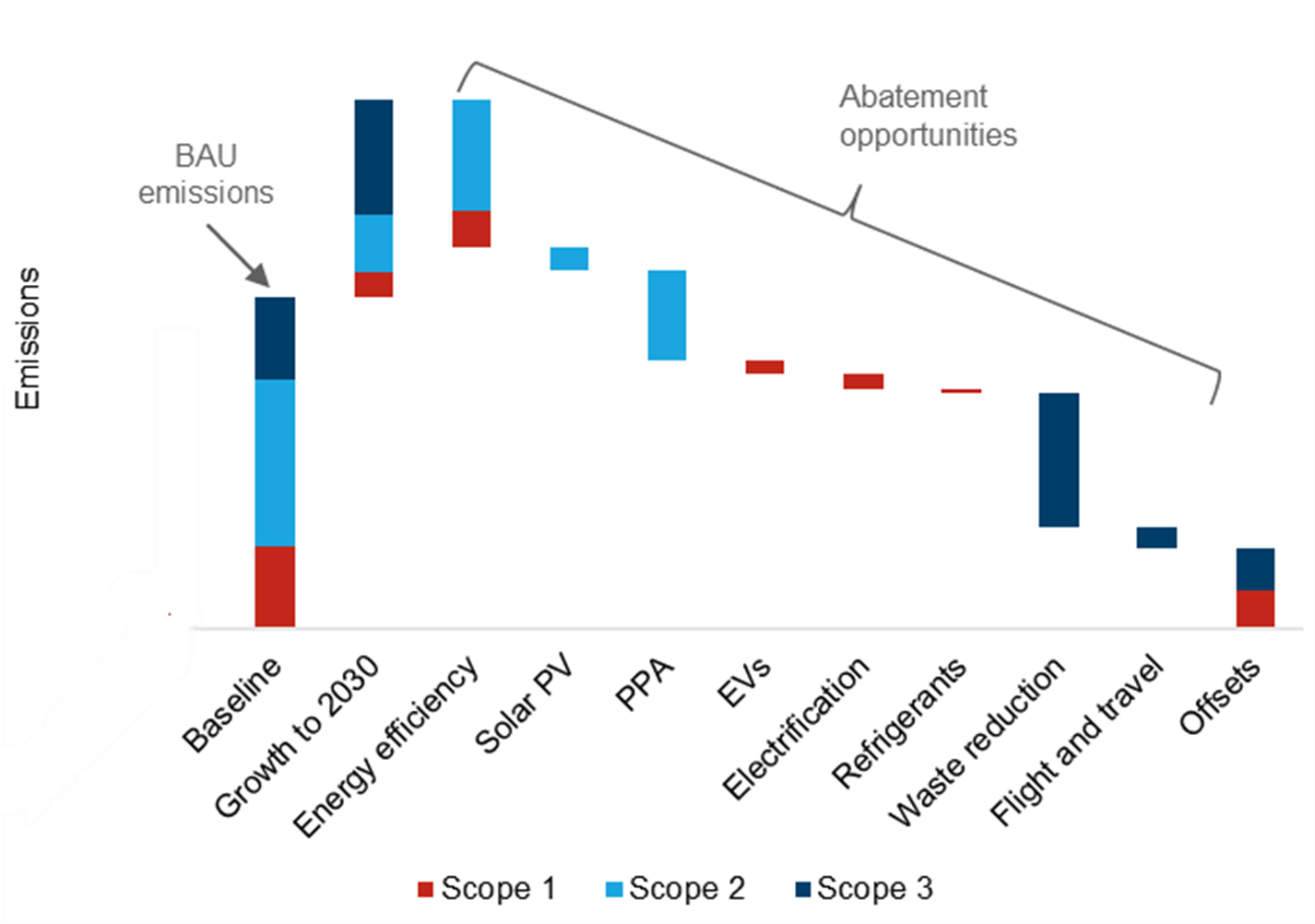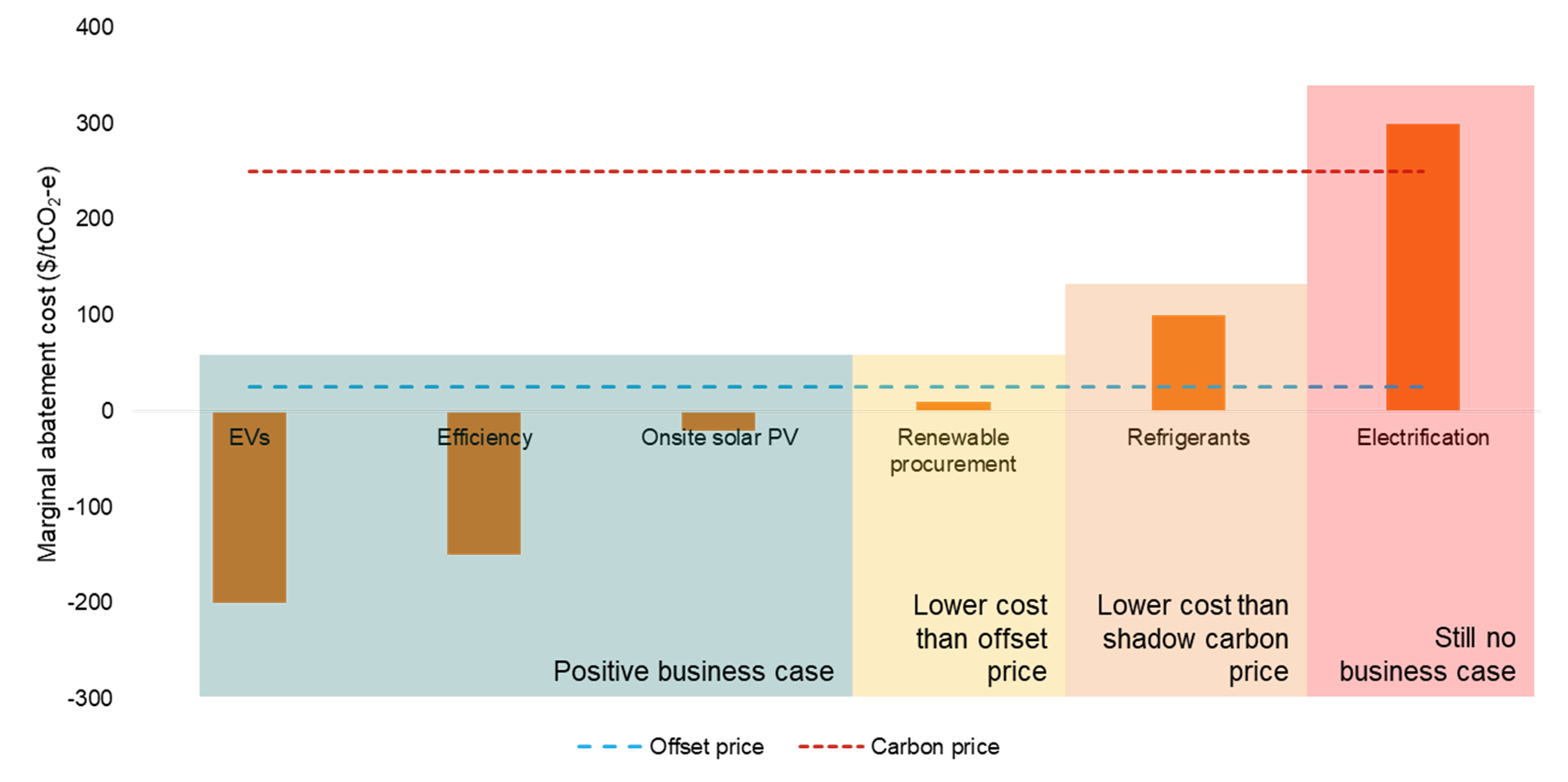Simply put, net zero is the practice of balancing emissions generated through human activities with emissions removed from the atmosphere. The ability to achieve net zero from company to global level, requires a combination of procedural and cultural changes to either fully abate emissions or reduce emissions as far as possible before purchasing offsets for any residual emissions. The waterfall diagram seen in Figure 1 shows an example of how emissions reduction and abatement activities can contribute to a net zero strategy. Typical opportunities providing the largest impacts are often renewable electricity either through renewable electricity procurement or on-site solar PV, and energy efficiency. In this article we focus on the value that can be created through energy efficiency programs.

Figure 1: Typical waterfall chart
Efficiency first! A net zero strategy
The aim of an energy efficiency strategy will always be to reduce total energy requirements. Often a significant element of a business’ cost base, despite prices softening through recent months, energy costs have been a focus for many organisations over the past 5-10 years. For decarbonising economies, improving energy efficiency can support the triple bottom line of profit (reducing costs or producing more product for the same amount of energy), planet (reducing emissions and the impact of climate change) and people (improving social impacts through reduced climate impacts or improved working conditions). As an organisation, understanding your specific energy consuming equipment / processes will be key to identifying suitable solutions. Depending on this energy use profile, solutions may include modifying or replacing equipment with less carbon intensive technologies and processes, and/or aligning energy consumption with periods of high renewable generation.
A holistic approach to decision making is required to assess each opportunity’s energy and associated emissions reductions, as well as the whole of life costs of each option including energy savings, maintenance savings, and any other additional benefits.
When adopting an ‘efficiency first’ mindset towards developing a net zero strategy, efficiency should be built into decision making processes to consider these whole of life costs, and challenge employees to improve efficiency across the business. Furthermore the concepts that are developed as a part an efficiency strategy should permeate the entirety of a net zero strategy.
How does efficiency impact my emissions?
In a typical net zero strategy, onsite generation, and the establishment of a corporate Power Purchase Agreement (PPA), are the abatement opportunities that target 100% renewable electricity. If efficiency opportunities have not been explored prior to implementation of onsite projects, it is likely to result in an oversized, unnecessarily costly, and potentially, overly complex renewable energy project design. An increasingly seen feature of onsite generation is a storage system which will also be sized based on calculated energy use and requirements. Larger storage requirements will again lead to unnecessary cost and complexity.
With an efficiency first approach, the volume required to be purchased through a PPA is lower and can result in a leaner, more considered use of renewable energy reducing the overall procurement of renewable energy certificates. This also reduces risk to the business as part of any renewable energy hedging strategy.
These renewable energy options have no impact on scope 1 emissions from onsite energy use such as natural gas or liquid fuels. However, with an efficiency first philosophy, efficiency techniques such as improvements in process heating, reduced vehicle fuel use or electrification of systems can be explored to further reduce emissions.
By its nature, energy efficiency often has the biggest impact on scope 1 and scope 2 emissions. However, there are opportunities for efficiency strategies to also reduce scope 3 emissions. The impact on scope 3 comes from a more considered use of resources and results in a change of behaviour culminating in reduced consumption of products, services, and energy.
Finally, it is unlikely that all emissions will be addressed through abatement strategies. As such offsetting will often be needed to achieve a net zero goal. Efficiency philosophies throughout the net zero strategy will ensure that the resulting amount of required offsets is minimised, reducing the cost and the subsequent future price risks associated with them. Organisational reputation can also be enhanced through the limited use of offsets. An organisation that achieves net zero solely through their own initiatives or with minimal reliance on outsourcing of emissions abatement is often more highly regarded for their response to climate change.
Valuing efficiency first
As discussed previously, energy efficiency reduces energy costs. However, there is further value that can be created for organisations making efficiency gains. If certifications and accreditations are achieved such as NABERS and Greenstar, improvements in these scorecards can increase the value of property and rental yields. Additionally, energy efficiency activities will often improve the quality of the technology being used and thereby improve working conditions. These resulting impacts are often overlooked within assessments of potential investment, where energy cost saving is the predominant factor. However, with a more forward focus, increased productivity and other co-benefits can improve the attractiveness of the efficiency investment.
When considering cost risks associated with offsets, reducing energy consumption mitigates this risk. Offsets are an ongoing cost, potentially increasing in future periods should the demand for offsets continue to increase. Historically, energy efficiency projects with a positive return on investment or a negative marginal abatement cost have been supported. This is shown in the example shown in Figure 2 with projects below $0/tonne typically implemented However, the consideration of offset pricing (either an offset price or a shadow price on carbon) is shifting the focus to projects that provide a lower carbon abatement cost than the cost of procuring offsets (marginal abatement cost < offset price). In this example, the offset price is set at $25/tonne and the carbon price set at $250/tonne. Implementing a carbon price into investment decisions will strengthen the decision-making process and ensure that projects are not implemented that have a negative impact on the net zero strategy.

Figure 2. The impact of carbon price on investment decisions
Where should efficiency sit in a net zero strategy?
The answer is, across all of it. The biggest argument for energy efficiency and an efficiency first approach in a net zero strategy is ultimately cost savings and risk reduction for a business. Considered and thoughtful energy use, ownership of energy use, and the incorporation of energy efficient technologies saves money and continues to save money over time. Without an efficiency first approach, additional on-site solar, off-site renewable energy, and carbon offsets will be required to reach a net zero target which have significant capital and operational cost impacts. Embedding efficiency within the culture of the organisation can also support the implementation, uptake, and ownership of the net zero strategy amongst all members of the organisation.
Energetics can support organisations in understanding their energy use, identifying opportunities, and developing energy efficiency and net zero strategies. Contact one of our consultants for further information on the services we can provide.






